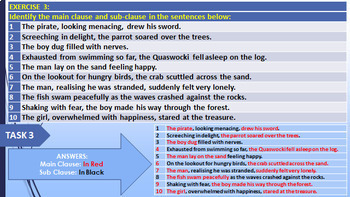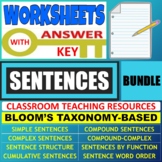SENTENCE KINDS BY STRUCTURE: 30 WORKSHEETS WITH ANSWERS
JOHN DSOUZA
1.1k Followers
Grade Levels
6th - 8th
Subjects
Resource Type
Standards
CCSSL.6.1c
CCSSL.6.1e
CCSSL.6.2a
CCSSL.6.3a
CCSSL.7.1c
Formats Included
- Word Document File
Pages
41 pages
JOHN DSOUZA
1.1k Followers
Also included in
- A bundle of 6 products on teaching and learning resources of sentence structure based on New Bloom's Taxonomy.After completing this unit students will be able to:Recall the parts of a general sentence with examples.Identify the parts of particular sentences – simple, compound, complex, compound-compPrice $16.80Original Price $24.00Save $7.20
- This bundle of 9 products (Worksheets with Answer Key) is perfect for teaching Grammar and Punctuation. These no prep activities would be great for ELA lessons or ELA centers. Your students will love these exciting exercises that are excellent for student engagement.This bundle includes Worksheets oPrice $13.30Original Price $19.00Save $5.70
Description
Ready to use worksheets with answers on sentence structure based on New Bloom’s Taxonomy.
After completing this lesson, the students will be able to:
- Recall the parts of a general sentence with examples.
- Identify the parts of particular sentences – simple, compound, complex, compound-complex - with examples.
- Think of varied sentences – simple, compound, complex, compound-complex - to go with the given pictures.
- Implement the properties of sentences – simple, compound, complex, compound-complex - to discover their structure.
- Assess and verify the correct use of sentence patterns in writing.
- Create sentences with the given sentence structure and pattern.
This download includes:
- EXERCISE 1: Compare and contrast a phrase, clause and sentence. Use subject, verb and complete thought as criteria to differentiate. Use YES and NO to identify the difference.
- EXERCISE 2: Identify the parts of sentences in the given examples.
- EXERCISE 3: Identify the parts of a simple sentence with examples.
- EXERCISE 4: Identify the parts of simple sentences.
- EXERCISE 5: Identify the parts of a compound sentence with examples.
- EXERCISE 6: Identify the parts of compound sentences.
- EXERCISE 7: Identify the parts of a complex sentence with examples.
- EXERCISE 8: Identify the parts of complex sentences – Part 1.
- EXERCISE 9: Identify the parts of complex sentences – Part 2.
- EXERCISE 10: Identify the parts of a compound-complex sentence with examples.
- EXERCISE 11: Identify the parts of compound-complex sentences.
- EXERCISE 12: Think of varied sentences – simple, compound, complex, compound-complex - to go with the given pictures.
- EXERCISE 13: Implement the properties of simple sentence to discover its structure.
- EXERCISE 14: Implement the properties of compound sentence to discover its structure.
- EXERCISE 15: Implement the properties of complex sentence to discover its structure.
- EXERCISE 16: Implement the properties of compound-complex sentence to discover its structure.
- EXERCISE 17: Identify the function of clauses in general and their function in specific sentences – Part 1.
- EXERCISE 18: Identify the function of clauses in general and their function in specific sentences – Part 2.
- EXERCISE 19: Identify the function of clauses in general and their function in specific sentences – Part 3.
- EXERCISE 20: Assess and verify the correct use of sentence patterns in writing.
- EXERCISE 21: Create sentences with the given sentence structure and pattern.
- EXERCISE 22: Demonstrate the mastery of the use of sentence structure in writing.
- EXERCISE 23: Identify the errors in the use of sentence connectors in the following passages and write the correction.
- EXERCISE 24: Identify the following sentences as simple, compound, complex or compound-complex:
- EXERCISE 25: Roll the dice and find the sentence in column one that matches the number. Then roll the dice again and find the sentence that matches in column two. Finally pick a conjunction (coordinator or subordinator) to join the two sentences together. Your sentences must make sense.
- EXERCISE 26: Do as directed.
- EXERCISE 27: Follow the rules to place the commas in the correct places. First, you will need to work out where the main and sub-clauses are.
- EXERCISE 28: Identify the main clause and sub-clause in the sentences below
- EXERCISE 29: Combine the following sentences using either coordinators or subordinators.
- EXERCISE 30: Join the sentences by using subordinating conjunctions: when, where, if, although, because, since, while.
Here are some possible uses for these in your classroom:
- To challenge early finishers
- For effective tutoring
- As ESL stations and sub tubs
- As holiday work and homework
- For small group collaborations
- For an end of unit assessments
- For reinforcement and enrichment
This is what teachers say about these resources:
- SENTENCES LESSONS AND RESOURCES BUNDLE: Very thorough. These cover all the areas of need for sentence types and structures. - Steelers Fan
- SENTENCE STRUCTURE - 11 WORKSHEETS WITH ANSWERS: Great resource that can be easily used in the classroom. - Chris Macintosh
Customer Tips: How to get TPT credit to use for future purchases
- Please go to your My Purchases page (you may need to log in). Beside each purchase, you'll see a Provide Feedback button. Simply click it and you will be taken to a page where you can give a quick rating and leave a short comment for the product.
- Each time you give feedback, TPT gives you feedback credits that you use to lower the cost of your future purchases.
- I value your feedback greatly as it helps me determine which products are most valuable for your classroom so I can create more for you.
- Look for the green star next to my store logo and click it to become a FOLLOWER. You will now receive email updates about this store. Be the first to know about my new discounts, freebies, and product launches.
Find Me Here:
- TPT Store - JOHN DSOUZA
- Pinterest - JOHN DSOUZA
- Facebook - TOMORROW’S CLASSROOM TODAY
- Instagram - JOHN421969
- Twitter - JOHN421969
- Blog - TOMORROW’S LESSONS TODAY
Total Pages
41 pages
Answer Key
Included
Teaching Duration
N/A
Report this resource to TPT
Reported resources will be reviewed by our team. Report this resource to let us know if this resource violates TPT’s content guidelines.
Standards
to see state-specific standards (only available in the US).
CCSSL.6.1c
Recognize and correct inappropriate shifts in pronoun number and person.
CCSSL.6.1e
Recognize variations from standard English in their own and others’ writing and speaking, and identify and use strategies to improve expression in conventional language.
CCSSL.6.2a
Use punctuation (commas, parentheses, dashes) to set off nonrestrictive/parenthetical elements.
CCSSL.6.3a
Vary sentence patterns for meaning, reader/listener interest, and style.
CCSSL.7.1c
Place phrases and clauses within a sentence, recognizing and correcting misplaced and dangling modifiers.







